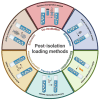Plant-Derived Exosomes: Carriers and Cargo of Natural Bioactive Compounds: Emerging Functions and Applications in Human Health
- PMID: 40648712
- PMCID: PMC12251442
- DOI: 10.3390/nano15131005
Plant-Derived Exosomes: Carriers and Cargo of Natural Bioactive Compounds: Emerging Functions and Applications in Human Health
Abstract
Extracellular vesicles (EVs) have gained increasing attention in recent years as a valuable focus of scientific investigation, owing to their potential therapeutic properties and wide-ranging uses in medicine. EVs are a heterogeneous population of membrane-enclosed vesicles with lipid bilayers, released by cells from both animal and plant origins. These widespread vesicles play a crucial role in cell-to-cell communication and serve as carriers for a variety of biomolecules such as proteins, lipids, and nucleic acids. The most common method of classifying EVs is based on their biogenesis pathway, distinguishing exosomes, microvesicles, and apoptotic bodies as the major types. In recent years, there has been a growing interest in PDEs, as they offer a practical and eco-friendly alternative to exosomes sourced from mammals. Mounting data from both laboratory-based and animal model experiments indicate that PDEs have natural therapeutic properties that modulate biological activities within cells, demonstrating properties such as anti-inflammatory, antioxidant, and anticancer effects that may aid in treating diseases and enhancing human well-being. Moreover, PDEs hold promise as reliable and biologically compatible carriers for drug delivery. Although studies conducted before clinical trials have yielded encouraging results, numerous unresolved issues and gaps in understanding remain, which must be resolved to facilitate the effective advancement of PDEs toward medical use in human patients. A key concern is the absence of unified procedures for processing materials and for obtaining PDEs from different botanical sources. This article provides a comprehensive summary of existing findings on PDEs, critically examining the hurdles they face, and highlighting their substantial promise as a novel class of therapeutic tools for a range of illnesses.
Keywords: bioactive molecules; cargo; carrier; human health; plant-derived exosomes.
Conflict of interest statement
The authors declare no conflicts of interest.
Figures





Similar articles
-
The Black Book of Psychotropic Dosing and Monitoring.Psychopharmacol Bull. 2024 Jul 8;54(3):8-59. Psychopharmacol Bull. 2024. PMID: 38993656 Free PMC article. Review.
-
Short-Term Memory Impairment.2024 Jun 8. In: StatPearls [Internet]. Treasure Island (FL): StatPearls Publishing; 2025 Jan–. 2024 Jun 8. In: StatPearls [Internet]. Treasure Island (FL): StatPearls Publishing; 2025 Jan–. PMID: 31424720 Free Books & Documents.
-
A rapid and systematic review of the clinical effectiveness and cost-effectiveness of paclitaxel, docetaxel, gemcitabine and vinorelbine in non-small-cell lung cancer.Health Technol Assess. 2001;5(32):1-195. doi: 10.3310/hta5320. Health Technol Assess. 2001. PMID: 12065068
-
Sexual Harassment and Prevention Training.2024 Mar 29. In: StatPearls [Internet]. Treasure Island (FL): StatPearls Publishing; 2025 Jan–. 2024 Mar 29. In: StatPearls [Internet]. Treasure Island (FL): StatPearls Publishing; 2025 Jan–. PMID: 36508513 Free Books & Documents.
-
Home treatment for mental health problems: a systematic review.Health Technol Assess. 2001;5(15):1-139. doi: 10.3310/hta5150. Health Technol Assess. 2001. PMID: 11532236
References
Publication types
Grants and funding
LinkOut - more resources
Full Text Sources

